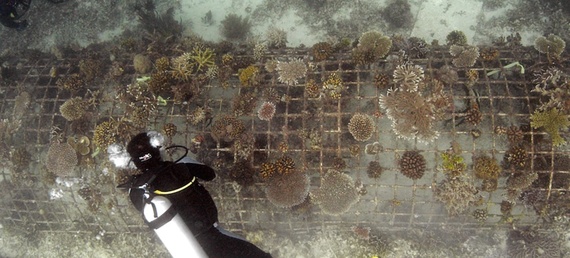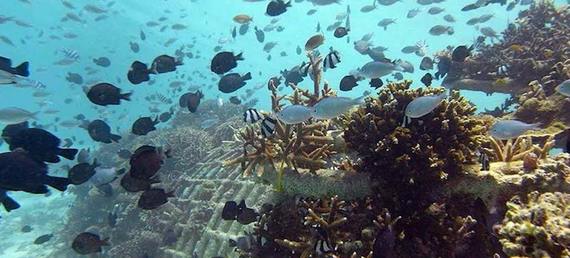
By Don Willlmott
Sometimes money really does talk. It's one thing to lament the continuing loss of the world's coral reefs due to rising ocean temperatures and acidity -- one study says they shrank from 240,000 square miles in 1997 to 108,000 in 2011 -- but it's quite another thing to put an actual price tag on that loss.
According to National Geographic, one eighth of the world's population relies on fish from coral reefs for food and income, and 100 countries benefit from the recreational value of reefs, which bring in nearly $12 billion tourism dollars annually. But that's just a drop in the ocean. Australian scientist Robert Costanza and his team published a study in the May issue of the journal Global Environmental Change that suggests the services coral reefs provide in terms of storm protection, erosion avoidance, food production, and more are worth $995,000 per acre per year, which adds up to $11 trillion annually. (When he extends his calculations to include the value of all land-based ecosystems as well, the grand total is a mind-boggling $142.7 trillion.) Something that valuable, the study clearly contends, is surely worth protecting.

Biorock frames can be made in any shape. (Source: Biorock International Corp.)
But how? To cite one example, more than half of Australia's Great Barrier Reef is bleached, if not yet dead, and ocean temperatures in that area have hovered one degree (F) above the hundred-year average for the past 20 years, which is very hard for delicate coral to tolerate. The story is the same the world over, so scientists are looking for ways to regenerate reefs without using the decidedly suboptimal strategy of, say, dumping millions of old tires in the ocean to create artificial reefs.
For decades, one of the most intriguing ideas has been to play with chemistry and electricity underwater to literally spark new life into reefs. You can see this scheme in action between the Indonesian islands of Bali and Lombok where, at a small archipelago called the Gili Islands, scientists are creating artificial reefs on a small scale by zapping metal frames with a weak electrical current.

Biorock frames provide an attractive habitat for many kinds of marine life. (Source: Gili Eco Trust)
Gili Eco Trust is working to implement "Biorock" technology to grow a limestone-like substance (mostly calcium carbonate and magnesium hydroxide) underwater. To date, 120 metal frames, some created in whimsical shapes such as motorcycles, have been deployed underwater at a cost of about $2,200 each. The technology passes a weak direct current through the metal. An electrolysis reaction pulls the limestone minerals out of the water, and they attach to the frame and create a substance just like a marine skeleton. The current has no effect on marine life or humans. Divers collect injured coral and transfer it to the frame, where the experts say it heals up to 20 times faster and has up to 50 times more chance of survival. Once the coral heals, it can be moved again to a reef.
In theory, Biorock frames could be massive if a way could be found to power them. Energy, of course, is the big issue. What sense does it make to burn fossil fuels in an attempt to address the issue of rising sea temperatures? Today, the frames must be small and stay close to shore. Installers have tried to deploy solar panels on barges as an alternative energy source, but the panels are often stolen. A better long-term solution might be underwater tidal turbines.
Protecting coral reefs is one of the many issues being addressed by the XPRIZE Ocean Initiative, a 10-year commitment to launch a total of five, multi-million dollar ocean XPRIZEs by 2020 (including the recently awarded $2M Wendy Schmidt Ocean Health XPRIZE). XPRIZE is in a unique position to galvanize a community of innovators, scientists, government officials, business leaders, philanthropists and ocean advocates in service of a bold vision -- to turn our oceans away from their current state of crisis and towards real breakthroughs to ensure that the world's oceans become healthy, valued, and understood.
Visit XPRIZE at xprize.org; follow us on Facebook, Twitter and Google+; and get our newsletter to stay informed.
Don Willmott is a New York-based journalist who writes about technology, travel and the environment for a wide variety of publications and websites.